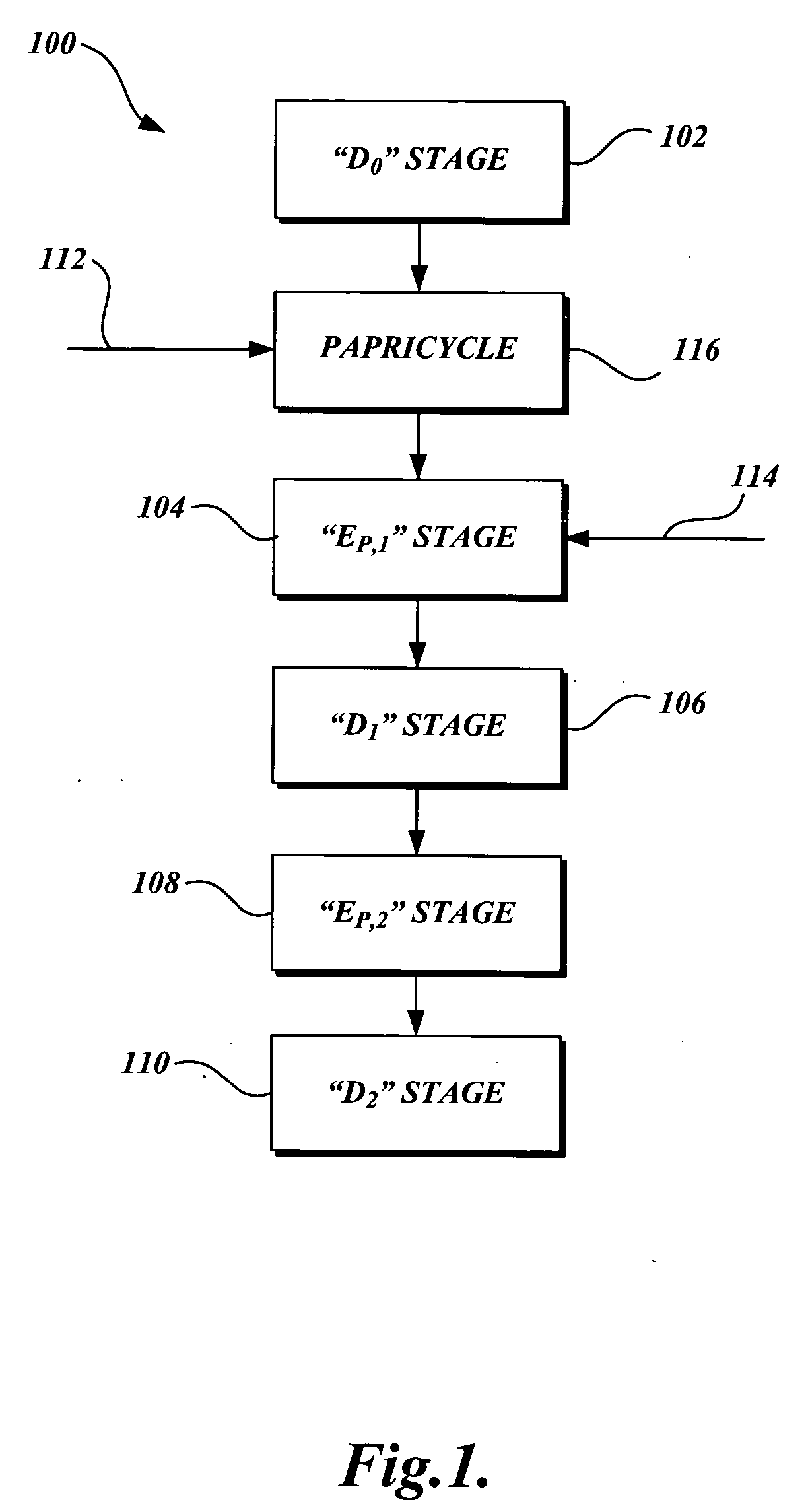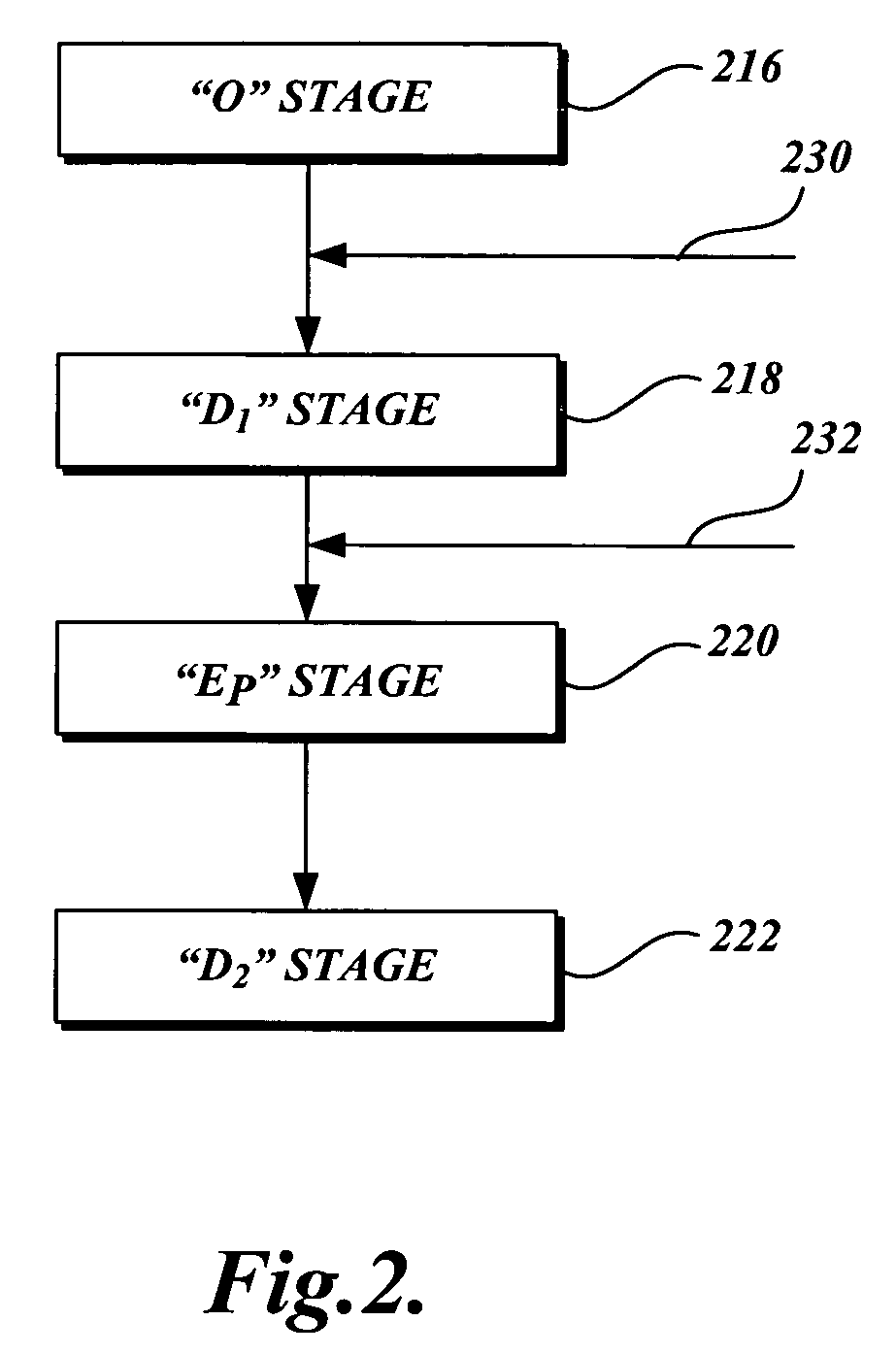Low pH treatment of pulp in a bleach sequence to produce pulp having low D.P. and low copper number for use in lyocell manufacture
a technology of low ph and bleach sequence, which is applied in the multi-stage pulping process, papermaking, and pulping with inorganic bases, etc. it can solve the problems of high purification cost of “alpha pulp” and unsuitable for use in lyocell manufacturing, degradation of amine n-oxide solvent, and high ph. , to achieve the effect of reducing the degree of polymerization of a pulp, high ph and reducing the degree of polymerization degr
- Summary
- Abstract
- Description
- Claims
- Application Information
AI Technical Summary
Benefits of technology
Problems solved by technology
Method used
Image
Examples
example a
Reduction of Degree of Polymerization at High pH with a Catalyst
[0046] Once dried pulp (NB416 fluff pulp available from the Weyerhaeuser Co. of Federal Way, Wash.) now having a consistency of 10% was mixed with 1.5% NaOH (based on pulp weight) and 1.5% H2O2 (based on pulp weight) in a container and bleached at 90° C. for one hour in a lab. A catalyst was added to increase the reduction of degree of polymerization of cellulose. A control sample has a degree of polymerization of 1310. The results are summarized in Table 1.
TABLE 1CATALYSTS FOR H2O2 BLEACHING OF PULPCatalystin waterD.P.D.P.PulpCatalyst(ppm)(post treatment)drop (%)NB416-dryNone1310NB416-dryWater / H2O2 / NaOHnone116511NB416-dryFeCl2.4H2O13.6101523NB416-dryFeCl3.6H2O11.289432NB416-dryMnCl2.3H2O13.512415NB416-dryMnCl211.212425
example b
Reduction of Degree of Polymerization at High pH with a Catalyst
[0047] Never dried pulp from the Weyerhaeuser Company's Kamloops mill from the D1 stage having a consistency of 10% was mixed with NaOH and H2O2 in a container and bleached 90° C. for one hour in a lab. Sodium hydroxide was added at the rate of 1.5%, and hydrogen peroxide was added at the rate of 1.5%, where percent is based on the weight of the pulp, unless otherwise indicated. A catalyst was added to catalyze the reduction of degree of polymerization of cellulose. The pH was greater than 8. A control sample has a degree of polymerization of 939. Some of the samples were washed with deionized (DI) water prior to bleaching. The results are summarized in Table 2.
TABLE 2CATALYST EFFECTIVENESS FOR BLEACHING OF MILL SAMPLESCatalystD.P. / copperin waternumber (postPulpCatalyst(ppm)treatment)D.P. drop (%)Kamloops D1None939Kamloops D1Water / H2O2 / NaOH078117Kamloops D1Double H2O20698 / 0.826Kamloops D1FeCl3.6H2O13694 / 0.826Kamloops...
example c
Reduction of Degree of Polymerization at High pH with a Catalyst
[0049] Never dried pulp (centrifuged Kamloops D1 pulp) having a consistency of 10% was mixed with 1.0% NaOH (based on pulp weight) and 2.0% H2O2 (based on pulp weight) in a container and bleached at 88° C. for one hour in a lab. The pH was greater than 8. A catalyst was added to increase the reduction of degree of polymerization of cellulose. A control sample has a degree of polymerization of 939. The transition metals Ca and Mg that are normally present in the mill are simulated by adding water containing low concentrations of these elemental transition metals. The results are summarized in Table 3.
TABLE 3MILL WATER IMPACT ON BLEACHINGD.P. / copperCatalystnumberCu / Fein water(post-in finalPulpCatalyst(ppm)treatment)CommentproductKamloops D1None939Kamloops D1Water / H2O2 / NaOH07891.0% H2O2 on10pulpKamloops D1Water / H2O2 / NaOH0711 / 0.86 / 4Kamloops D1Water / H2O2 / NaOHWater*939 13 ppm Ca / 3 ppm Mg / 0.3 ppm Mn inwaterKamloops D1CuSO...
PUM
| Property | Measurement | Unit |
|---|---|---|
| pH | aaaaa | aaaaa |
| degree of polymerization | aaaaa | aaaaa |
| degree of polymerization | aaaaa | aaaaa |
Abstract
Description
Claims
Application Information
 Login to View More
Login to View More - R&D
- Intellectual Property
- Life Sciences
- Materials
- Tech Scout
- Unparalleled Data Quality
- Higher Quality Content
- 60% Fewer Hallucinations
Browse by: Latest US Patents, China's latest patents, Technical Efficacy Thesaurus, Application Domain, Technology Topic, Popular Technical Reports.
© 2025 PatSnap. All rights reserved.Legal|Privacy policy|Modern Slavery Act Transparency Statement|Sitemap|About US| Contact US: help@patsnap.com



